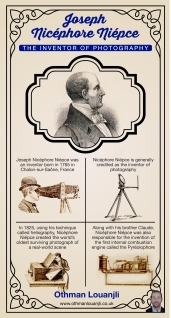Photography has a long and complex history, which began in antiquity with the discovery of the camera obscura. Camera obscura is a Latin phrase that translates as ‘dark room’, and is also referred to as a pinhole image. The term camera obscura describes the process of an image that appears on the other side of a screen with a small hole in it; the projected image appears as reversed and inverted when passed through this hole. In order for the image to be clear, the room with the projection must be darkened; therefore, many camera obscura experiments were set up in very dark rooms. For more information on the camera obscura, please refer to the embedded PDF.
PDF – (THE DEVELOPMENT OF THE CAMERA OBSCURA)
The camera obscura is a natural optical phenomenon. However, it seems that no one attempted to capture images in a permanent way using light sensitive materials until the 18th Century. In 1717, Johann Heinrich Schulze, a German anatomy professor and polymath, managed to capture letter shapes on a bottle of light-sensitive slurry, although he did not go further in order to make the resulting image durable.
Thomas Wedgwood was the first to make reliably documented photographic images, in the form of finely detailed photograms. However, he was ultimately unsuccessful in making permanent images. The French inventor, Joseph Nicéphore Niépce, is often credited as the man who invented photography, and he was certainly a pioneer in its development. Around 1826-27, Nicéphore Niépce used a primitive camera to create the world’s oldest surviving photograph of a real world scene, but his process required an extremely long exposure time – from a minimum of eight hours up to several days.
Louis Daguerre, the inventor of the daguerreotype, was an associate of Nicéphore Niépce and his photographic process went on to become the first commercially viable technique. Daguerreotypes produced clear and detailed images after only a couple of minutes of exposure and the process was given as a ‘gift to the world’ in 1839, which is now considered to be the year that practical photography was born.
Many more innovations followed the daguerreotype, which saw the exposure time reduced from minutes to a fraction of a second. More recently, digital photography has meant that the process has become cheaper, easier and more convenient. Therefore, those with in interest in photography such as Othman Louanjli can more easily take it up as a hobby.
There have been many inventors, scientists and artists that have been important in the development of photography. Some more notable figures include: James Clerk Maxwell, the Scottish physicist who created the first colour photograph in 1861 by photographing an object three times, through red, blue and yellow filters; and Edward Muybridge, who was the first to successfully capture the sequence of movement in his series of animals and people in motion, which was a technique that was important in the development of motion pictures.
Land Cameras were invented by Edwin Land and were instant cameras that used self-developing film. Land’s invention was manufactured by Polaroid from 1947, and the first model – the Polaroid Land Camera Model 95 – developed photographs in around 1 minute. Other historic camera models include the Contax S, which was the first pentaprism SLR camera; the Asahiflexl, which was the first Japanese-made 35mm SLR; and the Nikon F, the first camera that could be altered and adjusted thanks to its system of interchangeable components.
The first digital camera was invented in 1975 by Steven Sasson, an engineer at Eastman Kodak. The camera recorded 0.01 megapixel black and white photographs onto a cassette tape, which could be played back to display the image on a television monitor. After Sasson’s invention, digital technology moved at a fast pace with the invention of static RAM memory in 1988 and solid-state flash memory being invented in 1993, which is the same type of memory that is used in most digital cameras to this day.

You must be logged in to post a comment.